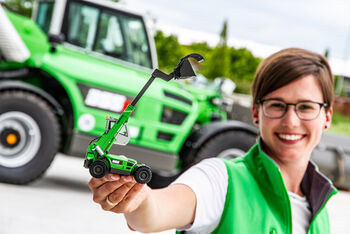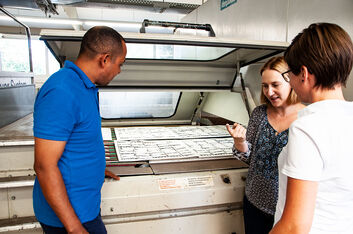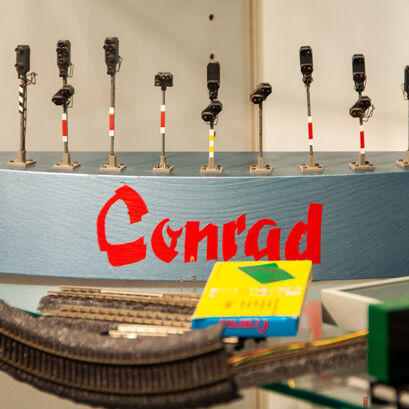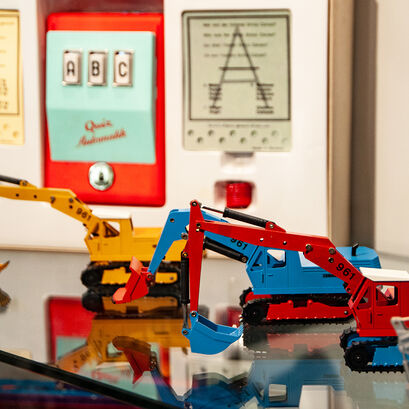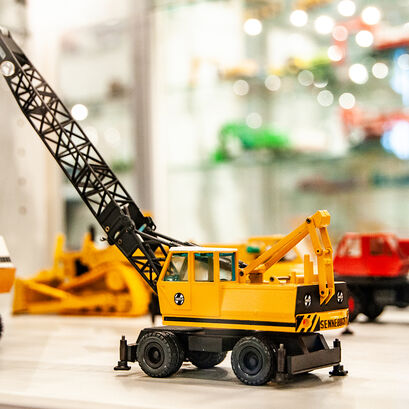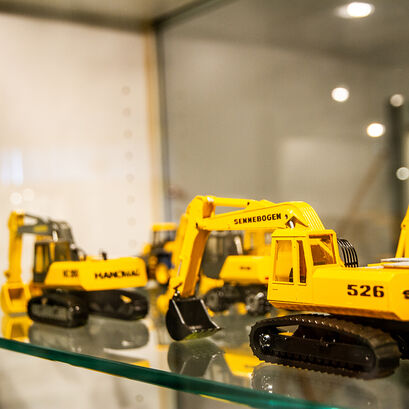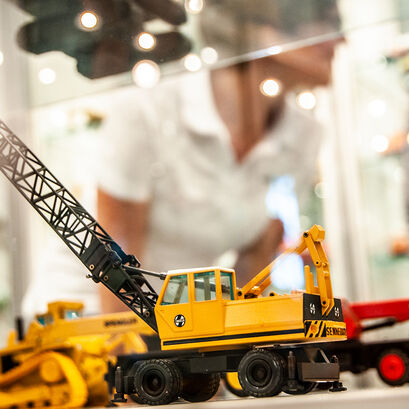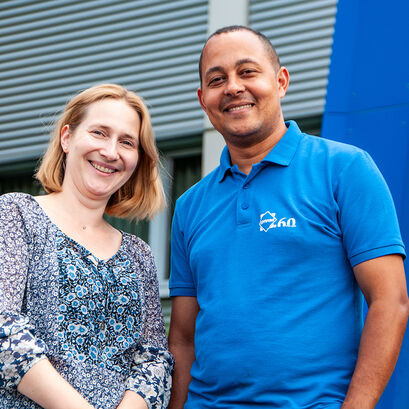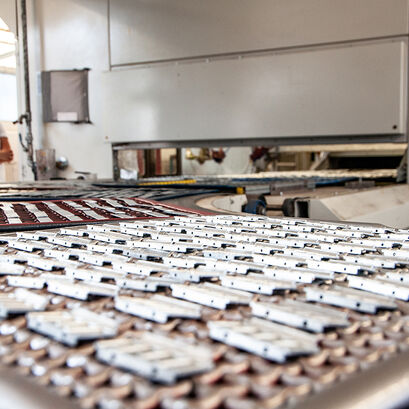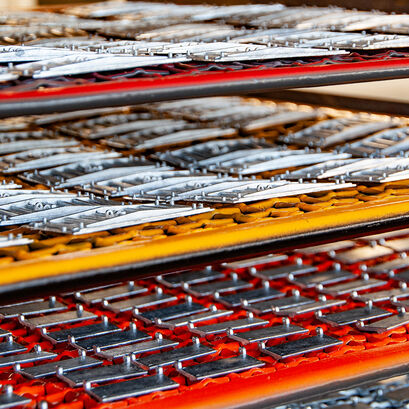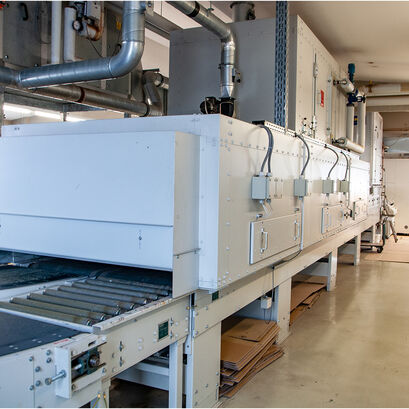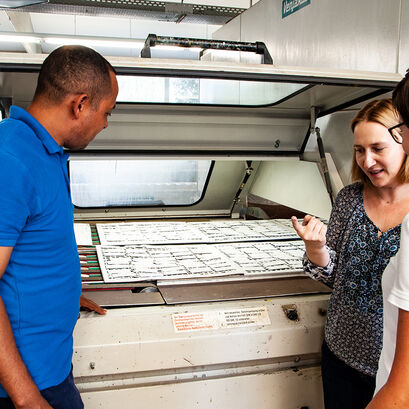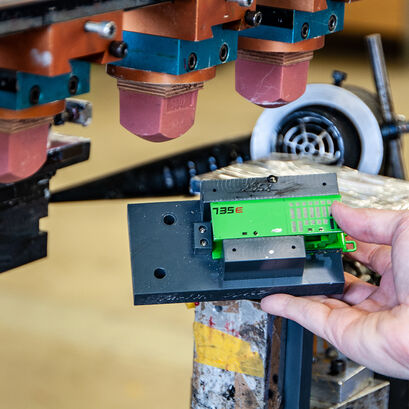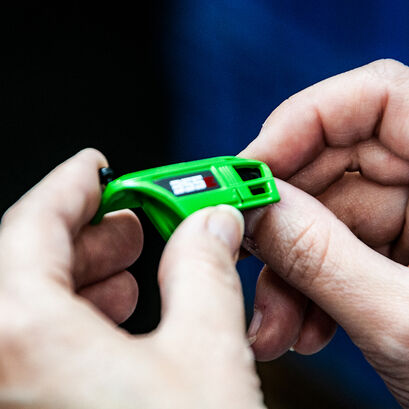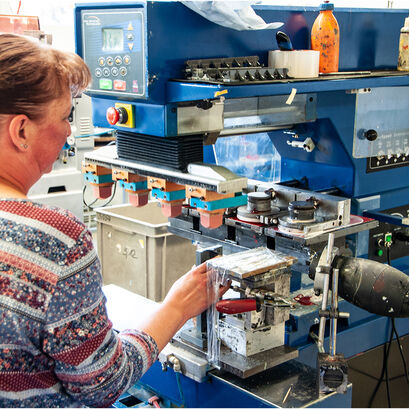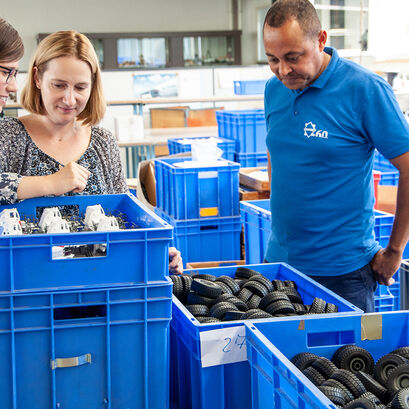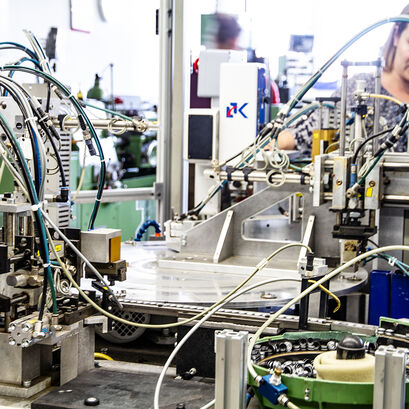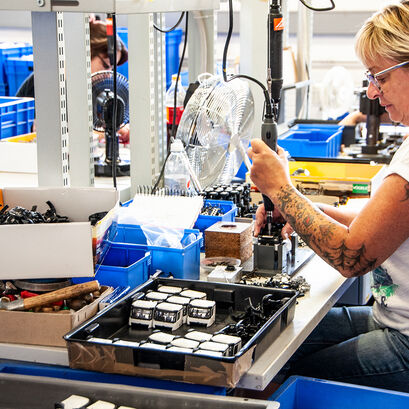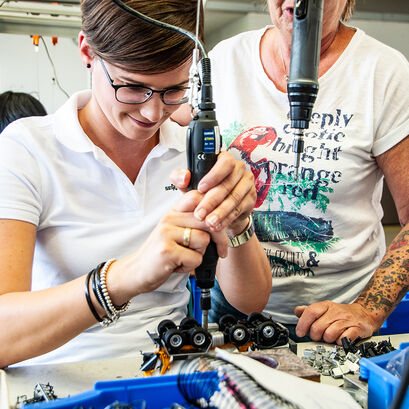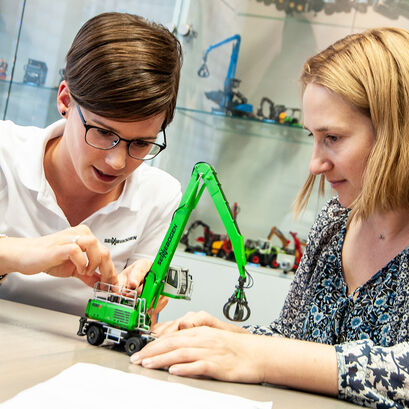Behind the Scenes at Conrad Modelle
Als Modellbauer hat das Familienunternehmen Conrad aus dem fränkischen Kalchreuth eine lange Tradition. Seit 1956 entstehen nahe Nürnberg hochwertige Baumaschinemodelle für Kunden und Sammler aus aller Welt. In dritter Generation führt Christine Conrad das Unternehmen und gibt im Interview Einblicke in die Geschichte und erklärt, was ein Conrad Modell ausmacht.
Making a model requires a lot of manual work
No collector’s display case should be without one and the miniature versions also look great on desks. We are talking about our 1:50 SENNEBOGEN scale models. We visited Conrad to find out exactly what is involved in the development of each model and how the models are produced in Germany.
Managing Director Christine Conrad and her husband Paul Bitschin welcomed us together and introduced us to the world of models. It was impressive to see the showroom full of countless models from all down the ages. We learned that the company started out making toys and that company founder Ludwig Conrad created the speed regulators for the first Carrera race tracks.
The most exciting bit, however, was being taken on a tour of the production facility by the third generation director of the family company. From the smallest plastic components to the largest die-cast zinc parts, a lot of manual work goes in to developing, producing and assembling the models in Kalchreuth. A model can have up to 1,500 individual parts. The molding and casting tools have to be developed for each component, along with the construction of hundreds of assembly fixtures so that the components can be attached with precision later on. Paul Bitschin maintains an overview of production and explained to us how they get a perfect glaze on the painted parts. For a number of years they have been using environmentally-friendly, water-based coatings.
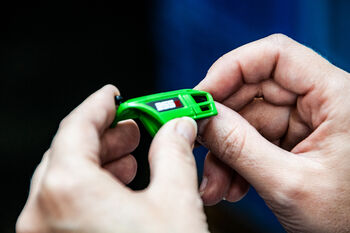
A lot is done by hand. Components are sanded, cleaned and painted before moving on to the next step. Tampon printing means that even the smallest of logos and markings can be faithfully and durably added. “It's these small details that make our models special,” says Christine Conrad. There are 10 steps involved just in printing the side panel of a 735 material handler. Lid handles, cooling grates and machine lettering all need to be printed in a range of colors. “The tiny 2 mm Green Efficiency Logo is always a real challenge,” explains Paul Bitschin.
Even the tiniest of inaccuracies with any of the four colors is critical. Once all the components have been painted and printed, it’s on to the assembly. Working very precisely by hand, employees put the individual pieces together. This requires an instinctive flair. We had a go ourselves and failed miserably. We will leave it to the professionals.
Two of the complex assembly processes have now been automated. Paul Bitschin showed us the systems that pre-assemble the tires and attach the chain links. Tiny chain links run on a spindle, compressed air is used to align them and then a wire nail connects them into a chain. Nearby, a bolt pushes a miniature tire onto a rim, which is then also immediately painted. This is all done automatically, but everything else is done by hand. Finally, each model is inspected by quality control once again. Do all the wheels turn? Are the cab windows secure? Are the paint and markings correct? Once they are satisfied, the models move on to be packaged and are then on their way to customers and collectors around the world.
Conrad currently produces six models for SENNEBOGEN, from the small 355 E telehandler to the big 5500 E crawler crane. Christine Conrad and Corinna Diem from the SENNEBOGEN Marketing Department are working on new models that we are looking forward to seeing.
Interview with Christine Conrad, Managing Director at Conrad Modelle
Located near Nuremberg, Conrad have been creating high-quality models of construction machines for customers and collectors all around the world since 1956. Christine Conrad is the third generation to run the company. She gives us an insight into the history of the company and what it is that makes a Conrad model special.
How do you actually become a model manufacturer?
My grandfather founded the company in 1956, and initially focused on the manufacture and development of model railway accessories and tin toys. Toy diggers quickly developed into a new market for scale models of machines.
During the post-war economic boom, well-known manufacturers had models of their devices and vehicles made for promotional purposes. Since then, Conrad has specialized in the manufacture of construction machinery and vehicle models at a scale of 1:50 and has become a globally established German manufacturer in this niche market. I personally have worked in the company since 2006 and really enjoy continuing our successful family tradition.
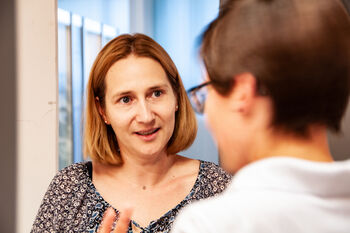
When was the first SENNEBOGEN model made and how did it differ from the green models that you make today?
The first model, in 1979, was the SENNEBOGEN mobile crane S 1018. We have added a few more along the way but each new model is a bit more special. We have high quality standards for the workmanship on our SENNEBOGEN models. With each model we try to further develop the level of detail and sophistication. The current model of the small SENNEBOGEN 355 E telehandler actually has more individual parts than the big dump truck that we are also currently producing. Small does not necessarily mean easy. There is also something else to take care of with SENNEBOGEN models - to be absolutely accurate in terms of color we paint both the metal and plastic parts.
How long does it take from an idea to the finished model? How many production steps are there?
On average, we need between six and eight months of production time. We start with the design, interpretation of the data and printing of a hand-sized 3D model. This can then be presented to the customer as an initial design. Once approved, the data is prepared for the tool making and we check to see if the components can be correctly formed. Then we cast or mold the first parts and paint them. Then comes another round of customer approval. Finally, we add logos and markings, assemble the finished models and send them to the customer, making seven key steps in total.
Why does Conrad base itself in Germany and what does the future hold?
Firstly, we have a clear responsibility towards our employees. Many of them have been with us for 30 years or more. I am certain that Conrad will still be making models in 10 years' time. The quantities and versions remains to be seen. We are constantly testing and developing new production methods, as well as focusing on technology that is used elsewhere and adapting it for the model industry. Manufacturing in Germany is, of course, time-consuming and costly. Whilst other manufacturers moved production to China, my father was clear that we are a manufacturer and not a service provider with a production facility somewhere else in the world. That was the right decision and I stand by it today too. We have all the necessary technology and process steps in one place here in Germany. This means we can react quickly, carry out repairs and feed changes into our processes.
How many models do you produce on average and what has been the most exciting model to date?
My favorite model tends to be whatever we are working on at the time. And the construction reinvents itself with each new model. The quantities vary a lot depending on the size and complexity of the machines and also on whether the sector uses models for advertising purposes. Take a forklift for example: this sector traditionally uses lots of scale models and so we produce up to 2,000 pieces a day. On the other hand, for other models the total circulation would never reach this volume. At the same time there is a balancing act in how technical to make the model. We cannot depict all the subtlety of the original in a 1:1 model, nor do we want to. It is important to us that our models can always be played with.
How has the model market changed over the last few decades?
For some time now we have noticed a generational change from models being given away to models being sold. Whereas in the past it was good practice to give away large quantities of models as promotional items, manufactures are now more inclined to sell the models in their own shops. When collectors have to buy the models themselves, it makes it harder to get into collecting in the first place. Today, scale models are more likely to be found on desks than in display cases.
As a model manufacturer, do you have to be a collector too? Do you have a display case in your living room?
No, absolutely not. I do not have any models at home. My father has some in his office though. Personally I need a mental balance, and I like to think about other things. Of course, I sometimes discuss work with my husband at the breakfast table, but that is the exception rather than the norm. We spend enough time during the working day talking about models.
Your contact person
Roxana Istel
Press inquiries
SENNEBOGEN
Maschinenfabrik GmbH
Sennebogenstraße 10
94315 Straubing

